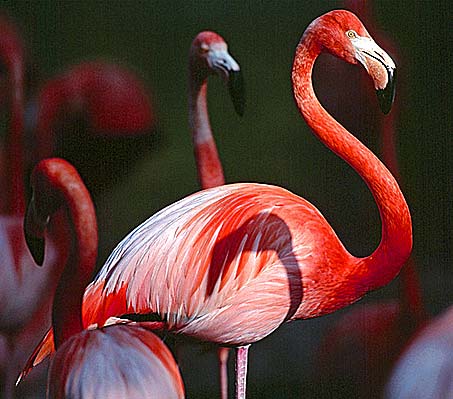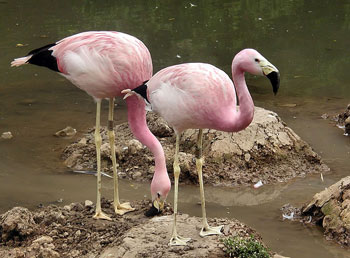Flamingos

More than just the inspiration for a common lawn ornament, the flamingo is an amazing creature that is found in diverse parts of the world – from hot climates in Central America to balmy Caribbean locales. This large “wading” bird can be found in shallow lakes, swamps, and lagoons. The adult can reach a height of nearly 4.5 ft (1.37 m) and weigh in at around 9 lbs (4 kg) with a wingspan of up to 5 ft (1.5 m). There are six different species of flamingos (Lesser, James, Andean, Caribbean, Greater, and Chilean) – all of which are considered to be very social – with some flocks reaching populations (called colonies) that number into the tens of thousands.
Beautiful Colors
The most distinguishable feature of the tall bird is its beautiful pink or reddish-pink color. This color is actually a result of the its diet of algae, small crustaceans, diatoms, and aquatic insects – or, more specifically – the pigments found in alpha and beta-carotenoid-rich food sources. The way that this coloration occurs happens like this: the bird eats the food, which is digested and then dissolved in fats that are later deposited into growing feathers, turning them to their tell-tale flamingo colors – much the same as the way shrimp changes color during the cooking process. If deprived of its carotenoid-rich food source, its plumage will be pale. In captivity, they are fed specially-enriched pigment pellets in order to maintain their beautiful colors.
How Filter Feeding Bird Feeds
As a filter feeder, their unusually shaped bill, when held upside down, contains lamellae which are plates that act like filters in order to trap “dinner” for this long-legged critter. It also uses its tongue to suck water in at the front of its bill only to pump it out through the bill’s sides later on.
Fun Flamingo Facts
- One of the oldest bird species still in existence, its fossils have been unearthed that were carbon dated to be as old as 50 million years.
- Flocks can reach speeds of thirty-one to thirty-seven miles per hour (48 to 59 kph).
- The webbed toes allow them to stand more easily in soft mud.
- This is a narcissistic creature; it will spend as much as 1/3 of its day “preening” – which is an act of grooming where it spreads oil from a gland near the tail throughout its feathers.
- Females lay one egg only; both the male and female take turns incubating the egg until a hatchling makes its appearance. Lucky liberated ladies!
- The adult birds have very few natural predators.
- Their lifespan is commonly twenty to thirty years.
- Resting is done by standing on one leg only.
- The “knee” is actually an ankle joint.
- To build their nests, they use mouthfuls of mud.
- There are no discernable differences in the male and female; both look alike to the untrained biologist’s eye.

The Andean flamingos are the only ones with yellow legs. They prefer high altitudes of 10000 ft (3050 m).
A Social Bird That Likes Company
- At Kamfers Dam in South Africa flocks of 20,000 gather.
- In Yucatan Mexico flocks of 25,000 gather.
- In Kenya at Lake Nakuru National Park over 100,000 Greater and Lesser Flamingos may gather.
- Claims have been made of more than 1.5 million lesser flamingos gathering in Eastern Africa which forms the largest flock of birds known of today!
